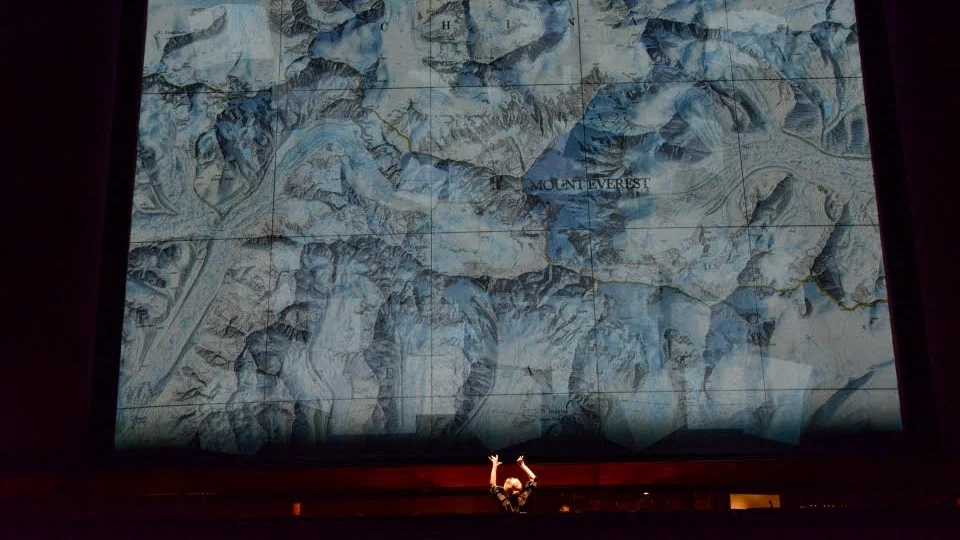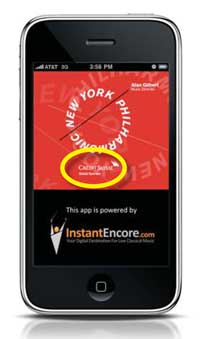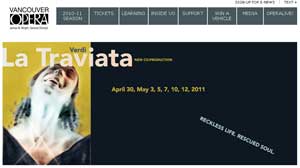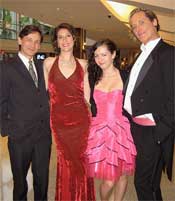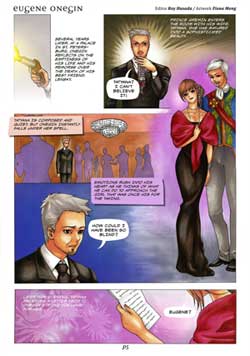Opera Australia attempts to make opera “for all” while maintaining the linguistic diversity of presenting opera in their original languages. To enhance the connection of audiences to the work, Opera Australia uses digitization and other technologies to create a holistic storytelling mechanism. This case demonstrates that (1) language and linguistic identity can advance and strengthen artistic storytelling and (2) audiences want to see linguistically diverse and accessible stories.
The Future of Technology in Opera
White Paper Wednesday: Data Practices in the Opera Industry
Learning From Leaders: Data Practices in the Opera Industry
How are marketing departments at large American Opera institutions using their data? This new Whitepaper by AMT-Lab Contributor Kevin O'Hora uses four case studies to paint a picture of how companies are using data acquired by their website. Full of insights for marketing departments across disciplines, this publication includes software recommendations as well as general strategies and best practices applicable to any arts marketer.
Operatic Analytics
It is easy to see the ways that the production and consumption of opera have changed to match the needs of the 21st century consumer. However, it is difficult to identify similar changes reflected in the way that opera is managed. Opera companies have altered the product they are offering, but have they come up with new metrics to measure and manage their success?
#TBT: The Web-Based Arts Experience
When discussing the future of the arts, many professionals and studies have stated that the manner in which audiences consume arts and culture is rapidly changing--and has already changed. The Internet has been the most notable new space for consuming culture, providing both opportunities and challenges through widespread and instant information sharing. Over the past several years, AMT Lab has documented the various web-based arts experiences that are becoming readily available--usually including lessons and best practices that managers can take away for their own practice. This week’s TBT rounds them up into a user-friendly toolbox of online arts experiences of various artistic mediums.
What do you think about your ticketing software?
We are conducting the 3rd National Ticketing Software Survey during the month of February. If you are interested in sharing your experience and your opinions about your software, please let us know. All those participating in the survey will receive a full copy of the report which will provide a national view as well as cluster analyses by discipline, budget size, and geographic region. The data will be useful for both organizations and vendors. Organizations will gain a better understanding of their own practices as compared to their peers and, more importantly, be able to use the findings as evidence for future technology funding campaigns. Vendors will have explicit evidence as to the needs and wants for future software design.
Performing Arts in the Wearable Age
Wearable computing devices--including smartwatches, fitness and health tracking devices, and smartglasses--are projected to quadruple between now and 2018. What does their increased use mean for the performing arts? In their follow-up paper to "Through The Looking Glass: How Google Glass Will Change the Performing Arts," guest correspondents Thomas Rhodes and Samuel Allen explain wearable technology, provide an overview of current experiments with these devices among performing arts professionals, and discuss potential implications and challenges for the field.
Attracting New Crowds
An ongoing concern of performing arts managers is the impact of arts participation and engagement programs on creating new audiences. Specifically, arts organizations are concerned as to whether or not their efforts elicit new patrons to attend performances regularly. Concerns exist in particular about the overall impact of engagement programs like simulcasts, wondering if a new audience members are attending these events at all, or if the events are drawing the same group of people that come to staged performances. Furthermore, a growing discomfort exists that opera simulcasts might actually be “cannibalizing sales,” or in other words, reducing ticket sales at live opera performances.
Research Update: From Simulcast Audience To Live Audience
San Francisco Opera's (SFO) general director David Gockley came to the company in 2006, bringing with him the legacy of free "plazacasts" that he had done at the Houston Grand Opera, his former home. During his first year at the San Francisco Opera, 8,000 people turned up at Civic Center Plaza near the Opera’s home at War Memorial Opera House to watch a simulcast of Puccini's Madama Butterfly. However, Gockley was concerned that there was no method of tracking the conversion of simulcast attendees to ticket buyers, so at the suggestion of a staff member, the simulcasts were moved to the AT&T ballpark.
Opera America: Celebrating 13 Companies’ Strategies for Audience Development
This week, Opera America announced the thirteen opera companies selected to share $300,000 in grants to support programs and projects that increase first-time opera attendance and return visits. The individual grants range from $7,500 to $30,000. The thirteen companies (and their projects) are:
Is it time to adopt 3D?
1) Market penetration is reaching a critical mass. 3D enabled devices now dominate the market and are poised to become a standard feature of home entertainment. 2) The cost of buying 3D enabled devices has gone down. TVs, playback devices (game consoles, dvr devices, etc), and cameras are more affordable than ever. 3) 3D Tech is now making strides into mobile devices with Nintendo, Google, and Motorola notably making devices and content for 3D mobile. 4) The tech offers solutions to art forms that heretofor were previously poorly served by older 2D imaging technology (aka dance and opera)
Cons:
1) 3D on film has been linked to nausea and headaches and even in video there have been questions about eye strain although these problems only seem to afflict a small portion of audience members. Evidently the trick is to not focus on out of focus images on the screen if you suffer from these problems. 2) It will be a couple more years before the majority of TV’s and Mobile devices can run 3D content. As with any technology there is only a point to which it will grow as people are reluctant to buy a 3D enabled HD TV (or playback device) a year after they shelled out for a new HD TV set. 3) There is the possibility that another breakthrough will be made in imaging that will make current imaging technology obsolete. For now, however, the long-term outlook seems to be favoring the current technology’s dominance for the next 6-8 years. 4) You still need those pesky glasses (for now at least).
One could argue that 3D still has a ways to go. The cutting edge of the field however offers the potential for much much more spectacular devices. Now that it is becoming fiscally accessible some artists and organizations have waded in and started experimenting but the potential remains largely untapped. Whatever happens, it will pay to keep a watch on this technology
Tech tools for your arts job search
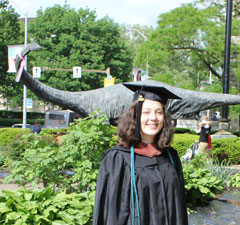 After two years writing for Technology in the Arts, I am leaving the Center for Arts Management and Technology. The unfortunate part about being a graduate student is that you will have to leave a place you love after a certain number of years, and my number is up! Special thanks to David and the rest of the CAMT staff for making the last two years amazing, educational, and memorable.
I am very excited about my new position with the data-driven arts and entertainment consulting firm TRG Arts. I have been hired as the Strategic Communications Specialist, which means I will serve as a writer and editor for the firm’s consulting projects, Data Lab research and analytics projects, and a contributor to TRG’s knowledge center online.
After two years writing for Technology in the Arts, I am leaving the Center for Arts Management and Technology. The unfortunate part about being a graduate student is that you will have to leave a place you love after a certain number of years, and my number is up! Special thanks to David and the rest of the CAMT staff for making the last two years amazing, educational, and memorable.
I am very excited about my new position with the data-driven arts and entertainment consulting firm TRG Arts. I have been hired as the Strategic Communications Specialist, which means I will serve as a writer and editor for the firm’s consulting projects, Data Lab research and analytics projects, and a contributor to TRG’s knowledge center online.
Before I leave Technology in the Arts, I wanted to share some of the secrets I learned during the last few months of looking for arts jobs, mainly at non-profit organizations. Because nonprofits usually begin their fiscal year in July, new positions at these organizations are often posted in the summer. That means now is the prime time for you to find your new dream job in the arts.
Here are my favorite tech tools to help you find that job:
Changedetection.com
Arts jobs often need to be filled quickly, which also means the time you have to apply is limited. We’ve all had the experience of finding a great—no, perfect—job and finding out that the “apply by” date has passed or being informed after you’ve submitted your resume that the company had already extended an offer to someone.
Changedetection.com comes in handy when you know that there is a company (or companies) you’d love to work for. Obviously you aren’t going to check in on the employment page of their website every day. Better that you just be notified when they post a job, right? Well, through the magic of technology, you can find out when that employment page changes. Changedetection checks the page every day, week or month (you specify which) and sends you an email when there has been a change.
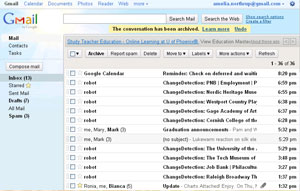
If there is a specific geographic location you know you’d like to work in, changedetection can help too. For example, I was looking for jobs in Portland at the beginning of my search. I looked on the arts council website and there wasn’t a job board, but I wasn’t going to let a silly little thing like that stop me! What the arts council site DID have was a listing of all the arts orgs in Portland. I put a changedetection on the employment page of each organization I was interested in and got on with my search.
The downside of tracking all these pages is that you might have to sort through some jobs that aren’t for you. For example, I looked mainly at full-time marketing jobs, but I was notified for ANY job at those companies, including development and box office jobs, and in some cases, internships. However, you can take this as an opportunity to build networks. If you see a great job in finance, maybe you have a friend who looking who also happens to be a finance whiz. Forward the job to her and not only have you strengthened your friendship, but also she may want to return the favor if she comes across a job that fits you.
I would recommend setting these up relatively early in your job search and keep adding as you find companies that are of interest to you. This way, you will also see which jobs come up and how frequently as well as important information like salary ranges and organizational structure information. (For example, will you be working for someone who is a new hire herself/himself? Is there a new Executive Director at the org?)
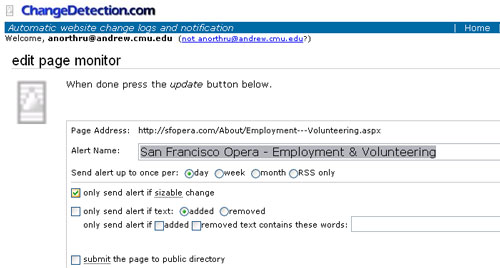
The interface for monitoring a page on ChangeDetection.com
LinkedIn has attempted to tout itself as a job-finding service. However, at the early-career/emerging leader level, I find that is less helpful for finding jobs and more helpful for simply networking. There’s not that many headhunters out there for arts jobs, except in the executive level and maybe for IT people.
Anyway, how many times have we heard that the arts world is a small world? I use LinkedIn to see if there’s anyone I know who may know someone at the company I am applying to. If your relationship is good with that person, ask them to put in a good word for you.
Sometimes LinkedIn groups will have job postings; I haven’t found this to be true for most of the arts admin/management groups though. Please comment below if you know of a good group for this.
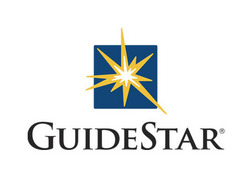 GuideStar
GuideStar
For non-profit organizations, it’s essential to check out the company on GuideStar. GuideStar is a free service that gathers and publicizes information about nonprofit organizations. Much of the information is geared toward donors and foundations, but there is a lot of useful information on it for the job seeker.
Once you register (free), you have access to almost any arts organization’s 990 tax forms, which means you can see what the organization’s budget size is and how they are doing financially. Note that for many organizations, the most recent year might be 2008 or 2009, so the information could be slightly dated or influenced by the recession—which is still important to know. The 990 serves not only as a way to see if the org has a record of keeping a balanced budget, but also as a historical snapshot of the organization, in terms of grants received, senior staff turnover, and capital campaigns and similar projects, among other things.
GuideStar is also extremely helpful to estimate salaries, especially if you are applying to a director-level position. The IRS requires non-profits to list the salaries of their five highest-paid employees. This is pretty valuable information, as the size of most non-profit arts organizations means that you aren’t likely to find very accurate information on that exact job at that exact organization.
Arts Jobs Sites
One of my friends posted a status update recently “wondering if CareerBuilder is really a builder”. I replied that all it had “built” for me was piles of emails in my spam folder. Personally, I’ve had a lot more luck overall with industry-specific sites, some of which can be used in conjunction with changedetection, as discussed above. (Bonus: The industry-specific sites manage to present you with jobs without asking if you want information from University of Phoenix every other time you go to look at a job. Just saying.) Here are my favorites:
General:
- CAMT’s own ArtsOpportunities
- Americans for the Arts' Job Bank
By discipline:
- Playbill Job Listings (mostly theatre)
- Theatre Communications Group's Arts Search (need a log-in and password for this one)
- Association of Performing Arts Presenters Job Bank
- Opera America Job Listings (also available as an RSS Feed)
- Dance USA Jobs in the Arts
- Association of Children’s Museums
- American Association of Museums' jobHQ
- Chronicle of Higher Education (mostly faculty positions at colleges and universities)
- Also, Createquity will occasionally post interesting opportunities, so that is worth adding to your RSS feed if you haven’t already.
State and local arts councils may have a good job posting site, depending on where you’re looking to find a job. For example:
- Greater Philadelphia Cultural Alliance
- Cultural Alliance of Greater Washington (Washington D.C., not Washington state)
- New York Foundation for the Arts
Lastly, if you have an interest in development or program management, heads up! There are a few sites/ email alerts that I’ve found especially useful:
Philanthropy News Digest (A service of Foundationcenter.org)
PND has created a job alert system that will email you a daily summary of recent jobs in your area of interest. I cast my net wide by checking a lot of states and position types (communications, development, program management, etc) when I signed up for the alerts. I now get about 15 job postings a day. The fields of the organizations are quite diverse too. A recent email contained jobs from Napa Valley Opera House, University of Chicago, the Rainforest Alliance, and Vera Institute of Justice.
Chronicle of Philanthropy posts mostly development jobs, which, like PND, you can sort by location, position type, and the field of the organization (education, health, museum, etc).
It’s also worth mentioning that DotOrgJobs is good for fundraising jobs and other nonprofit jobs; however, I have not seen a lot of arts-specific jobs from them. You can subscribe via email or RSS feed.
On organizing email alerts:
You might be saying to yourself, “That’s a lot of email alerts to deal with.” I use gmail and have set a rule to have these emails automatically labeled “job search” and archived so that they don’t clutter up my inbox. Then I set an alert on Google Calendar reminding me to go through them once a week, so that I actually read them! This can also easily be done with Outlook.
Do you know of any other good sources for arts jobs? If so, please post them below! Happy hunting!
Aluminum Foil Stage Curtains & Other Oddities
While cruising the net, trying to find the latest and greatest when it comes to arts management and technology, I tend to run across some pretty strange things. They often don't fit into the realm of the arts management focus of our blog, but dang it, they're just too awesome to keep to myself: I
The most stunning stage curtain, ever.
Artist Pae White has created for the Oslo Opera House what could arguably be the craziest main stage curtain to ever grace a stage. White scanned a piece of crumpled aluminum foil and then used a computer aided loom to weave the curtain out of different colors of cotton, wool and polyester. When standing up close, one can see the individual threads, but stand even just a few feet back and well.....well, just look at the picture below:
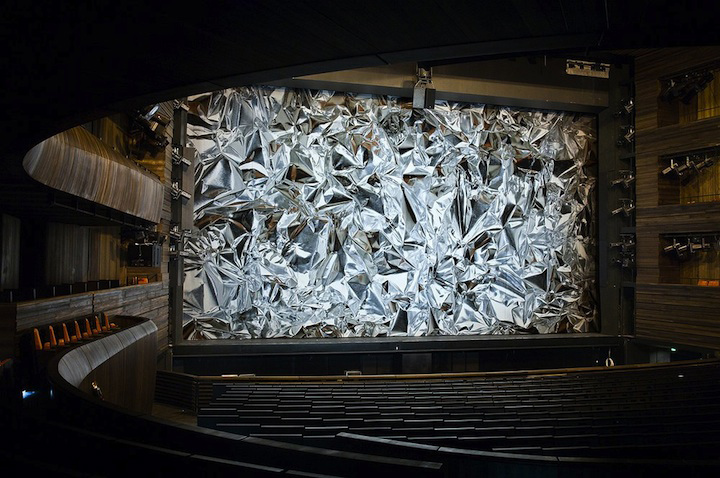
I went to Barcelona, and all I got was this crappy mini replica of myself.
BlablabLAB's Be Your Own Souvenir is a far cry from some of the cheap junk that you'll find at most souvenir shops. The group hacked a few Kinects, and with the aid of a 3-D printer, gave tourists on Barcelona's La Rambla Street the chance to scan themselves and create their own miniture statuettes. Check out the video below to see some of the results:
I
Theater? We don't need no stinkin' theater!
Ok ok, I'm sure that was not the sentiment that Urbanscreen had when they set out to make WHAT IS UP?, a virtual site-specific theater piece. The piece is a pre-recorded performance, projected onto the wall of a typical dutch dwelling house in Enschede, Netherland. What makes this a projection a site specific piece, also called Lumentecture, is that the projection perfectly lines up with the architecture of the building. Using this technique, Urbanscreen creates an optical illusion of the building's walls giving way to a hidden theater within. Watch the trailer below to get the full effect:
Instant Encore: Classical Music goes Mobile

- Margo Drakos, co-founder/COO of InstantEncore
Margo Drakos is a woman on a mission. The co-founder and COO of InstantEncore wants to take classical music directly to its audience via a host of online services, including a digital strategy package for powering custom websites for organizations, a website builder for artists and the development of mobile apps. Recently, the company has been busy building custom mobile apps for Android, iPad, iPhone and all smartphones. InstantEncore’s mobile apps have previously been featured on this blog in Tom’s article 10 Arts and Culture Mobile Apps from 2010.
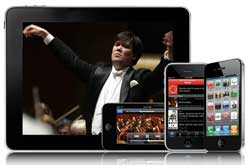 InstantEncore currently powers about 100 iPhone apps and 50 Android as well as hosting mobile web apps, which make an organization's website functional on a mobile phone. Their platform powers the app for the popular YouTube Symphony Orchestra, which, at over 125,000 downloads, and beats both the Taylor Swift and Linkin Park apps by about 90,000. Instant Encore also hosts the apps of notable organizations like the NY Philharmonic, Chamber Music Society of Lincoln Center, Cleveland Institute of Music and Houston Grand Opera.
InstantEncore currently powers about 100 iPhone apps and 50 Android as well as hosting mobile web apps, which make an organization's website functional on a mobile phone. Their platform powers the app for the popular YouTube Symphony Orchestra, which, at over 125,000 downloads, and beats both the Taylor Swift and Linkin Park apps by about 90,000. Instant Encore also hosts the apps of notable organizations like the NY Philharmonic, Chamber Music Society of Lincoln Center, Cleveland Institute of Music and Houston Grand Opera.
I talked with Margo recently to catch up on Instant Encore's latest endeavors.
What is InstantEncore? InstantEncore.com is a classical music platform that enables artists and arts organization to harness the power of technology to connect with their fans anywhere, any time. We are the infrastructure! We have created the only classical music-specific digital asset management system that essentially allows our Partners from a broad spectrum of the performing arts world to enter digital content – event listings, ticket selling, audio recordings (streaming, download, public or private), video (live or on-demand), news, blogs, and photos - one time, and have all of their content published in real time to their own website, mobile apps, Facebook or Twitter accounts.
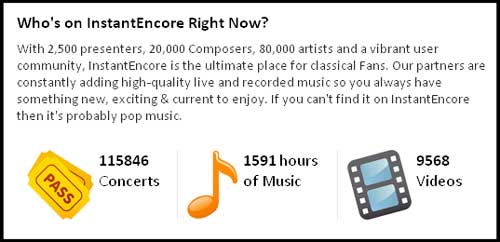 How did the idea for InstantEncore come about?
Two things happened: I was playing cello for a living and I had sort of grown frustrated with the disconnect between musicians and the audience, where the field was going, and how technology was disrupting the traditional models. I felt passionate about re-personalizing the concert experience without losing artistic integrity.
How did the idea for InstantEncore come about?
Two things happened: I was playing cello for a living and I had sort of grown frustrated with the disconnect between musicians and the audience, where the field was going, and how technology was disrupting the traditional models. I felt passionate about re-personalizing the concert experience without losing artistic integrity.

- An InstantEncore concert card offering a music download.
Meanwhile, I had the pleasure of meeting some wonderful engineers and they had a really powerful search engine specific for classical music that resulted in a high-end jukebox called Maestro. It had originally been created to help catalog vast CD collections, like that of our chairman/CEO. I was talking to them about how sometimes as a performer you would go to a live event and afterwards people would say “I loved the concert. How can I hear it again? How can I get a recording?” And of course I was always trying to sell some unrelated CD. So I talked to these engineers about this predicament that a lot of musicians always find themselves in, and so we actually created this concept of the “Instant Encore”—where you can take a card at the concert, go home, and download the content that you just heard.
How has InstantEncore evolved from the days of concert cards to now? Instant Encore started with a very powerful search engine that had organized and standardized all classical music meta data, and our objective was to build the tools that would enable fans to connect with the music and artists they love, in a personal, immediate way. We wanted to leverage technology to extend and enhance every aspect of the live concert experience. We are committed to providing the 21st century tools that will save organizations time and money by automatically or quickly powering their digital assets to connect with fans and engage sponsors.
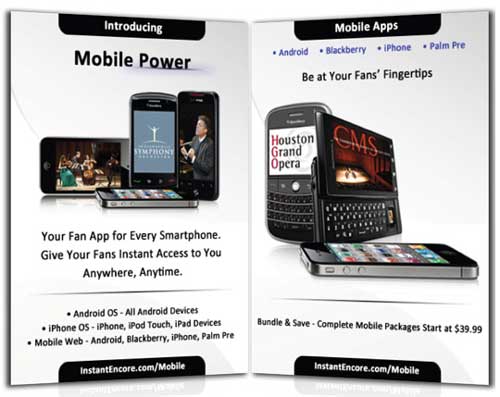
How does the Instant Encore component fit in with an organization’s existing social media presences and organizational website? Our goal is to streamline redundancies and save resources. Right now, you have a lot of people that are trying to update their website, spending a great deal of time developing a content management system internally instead of spending development time and resources on the front end. Then there is the mobile space--if an organization does not have a good web-browsing experience from a smartphone, people will close the site. Then organizations are manually pushing content that is often a PR push to Facebook and then to Twitter as well. So there’s a great amount of time and effort in trying to maintain all these very necessary social network platforms.
Obviously details about classical music can be a nightmare to organize or for data entry. We have a very standardized way—unless it’s a world premiere, it’s all in our search engine’s system. For example, if you start to type in “Beethoven Symphony No. 5”, it’s going to have the opus number and the key and all the movements and you just click on that and it’s automatically transferred. So, you’re never entering all that information yourself, which is 1) time-saving and 2) tagged at the most specific level, which allows people that are not looking specifically for you to find you and you that already know you and want to find you to customize their experience.
Our system is set up so that you as a Partner can enter an event listing in moments in our secure Control Panel. By that one simple event creation in our content management system, it updates in your website with our webbuilder or more advanced API (Application Programming Interface—see the end of this entry for more information). posts to the partner’s social networks, mobile apps, etc. You can do a host of different things—tag your YouTube channel. You can manually upload music for streaming or download purchase. Or you can create a private download code campaign for donors or concertgoers. One of our most valuable features is this web crawler that goes through hundreds of RSS feeds and finds articles specific to arts organizations and tag any article from newspapers or blog. This can automatically appear in your app or website as the latest news, so you’re not having to physically manage your app or site but your content is current.
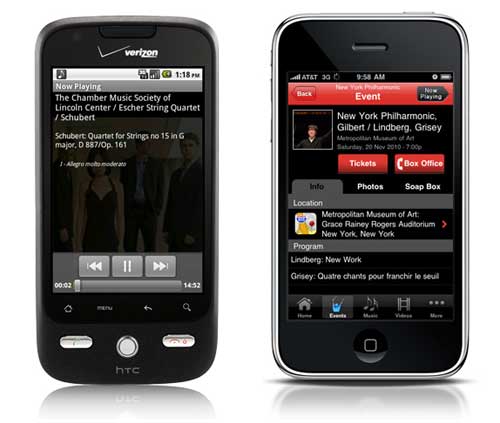 The music player feature on InstantEncore's Android app (left) and the events feature on InstantEncore's iPhone app (right).
The music player feature on InstantEncore's Android app (left) and the events feature on InstantEncore's iPhone app (right).
So basically it’s just a one-stop shop. It’s a digital asset management system where you come to enter your content in one place and it goes to all the platforms that you’re using. We’re just an aggregator and publisher of that content… Our concept was that it should be something that a two-person organization can use our tools and manage and have a very robust, beautiful integrated social media presence or an organization with a budget over 10 million can use the same tool.
Regardless of all the features you offer, many organizations might have trouble getting the rights to use pieces of music or convincing players that a mobile app is somewhere the music should be. What are some of the arguments you can make to convince them that this is something worth doing? I come from the musician/recording side of things, am a current member of the AFM and as a child was a member of AFTRA and SAG, so I certainly appreciate where the musicians are coming from. What I think is important is that, fortunately or unfortunately (however you want to perceive it) we’re in a new period that is such disruptive change, brought on in part by technology and change is always painful. There are new great opportunities but the existing models and the days of residuals in the way that we used to know it, at least right now, are not there. I think it’s really important to actually be very upfront about this. Artists are highly intelligent people and creative people and have wonderful ideas to bring to the marketing and development side of the business. I think it is so important that everyone be a stakeholder charting this new world together.
I think part of this is taking a holistic approach and saying that there are certainly a group of people that are going to want a physical CD’s and there’s people that are going to want to download content. But there’s a certain group of people know who just want what they want, when they want it. We see from our stats that music or videos are increasingly having a very short shelf life. People will often want to hear a new live recording over and over and then they move on and that is it. I often say to my friends and colleagues that you have to have some faith and work together to try things. Every community and every audience is different, but if you don’t have the tools to even explore or try things, that’s very challenging. I think mobile is so essential. People will be accessing the internet via their mobile devices more than from a computer within the next few years. If you don’t have a good user experience to access your content via mobile or any content in it, in my opinion, I think it will be very, very challenging.
You mentioned that you are focusing your research efforts on return on investment in digital media and how orgs can get sponsorship for their technology initiatives. Can you tell me more? Why should anyone care about social media and an integrated digital strategy? Why should anyone care about having a mobile app? I’m a very “nuts and bolts”, frugal person. When I look at some of the organizations that I work with and see how much they’re spending on print material and yet they don’t want to spend a few thousand on a mobile presence, or want to wait a few years to see where this mobile thing goes, I think it is quite alarming. Showing people the return on investment is critical for them to care.
Many organizations we are working with have packaged a digital or mobile sponsorship package and in many cases, new donors or people who were not previously interested in sponsorship at a significant level, are excited to be part of new technology, sponsoring live video streaming on websites and mobile platforms and much more.
It’s built into our platforms—ways for people to feature sponsors, going through their audience to create new audiences, etc. What I’ve found is that I’ve been pushing organizations to think outside of their printed program with a printed logo and think, how can we think outside of the box and take the old ways that we used to monetize and seek corporate sponsors and take this into the digital space? Some organizations have come up with some fabulous things. Whether it’s embedded streaming announcements featuring sponsors, ad spots with sponsors, getting grants to cover new educational and audience development initiatives—various things. They’ve been able to monetize this in new ways, from new sponsors (not cutting out of other things).
I am very excited that Telstra, the telecom company in Australia, hired us to create a premium custom app for the Sydney Symphony that will include live video streaming of ten concerts in their mobile apps and website. This is a win-win for everyone.
How should arts organizations approach technology? There are so many platforms out there, there is so much information and everything’s changing so rapidly. I remember launching the app with the New York Phil and at that time, apps were still—people thought “what the heck is that?” So, the most important thing is to integrate digital media strategy into organizational strategy—into every aspect of decision-making across all departments. It involves PR, it involves marketing, it involves development, it involves operations, the audio recording department, musicians—absolutely everyone. I think that buy-in is essential. I think one of the most important things is just to start small and get permission to try something. If it doesn’t work, don’t let it validate that “this is never going to work” and if it’s a home-run, that doesn’t mean that it’s going to work the next time. It’s important to look at just getting started but with a clear, integrated strategy approach. And really, actually, there’s a lot of fear sometimes when it comes to technology and I think part of what’s been fun to see is that oftentimes, it’s a lot more fun than people necessarily anticipate and I think that that’s been a really rewarding part of what we’re doing.
When Thomas Hampson made his recital available for download and Performance Today, Minnesota Public Radio, and European Public Broadcasting Union announced it on air. We read the comments from people from around the world—from United Arab Emirates, to Germany to California to Wisconsin—about how that music impacted them and how grateful they were for that. I was very honored and proud that some of our tools could be helping to connect the power of his voice and his artistry globally in a way that’s never happened before. I think that’s really what it’s about and instead of feeling more protectionist, as scary as it feels, to embrace democratized access in this engaged age.
More info on Maestro API:
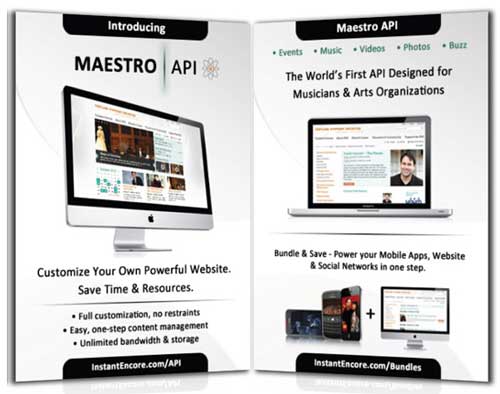
Opera by You: How to crowdsource a production
By this point we’ve all heard about crowdsourcing. It's a way to outsource a project and let a large group of people create it online. (See video at the end of the post for a fuller explanation, complete with animated fish.) We’ve heard about crowdsourcing logo designs, requests for proposals (RFP's) or even determining which paintings to show in an exhibition. But how about an full-length opera? Well, one company is crazy enough to try it.
The Savonlinna Festival in Finland has been developing an opera through the collaboration platform wreckamovie since 2010. The Opera by You initiative has been developed in five phases, some of which overlap. First, the crowd collaborated on a plot and name for the opera in July 2010. They decided on the title Free Will and the following plot, as described by Paivi Salmi, Project Manager of Opera by You:
God has had enough of all the misery that people are suffering from and calls a meeting with the angels. They decide to send a few dead geniuses back to Earth to make things better. They are supposed to make a huge difference in science and art and create world peace. The geniuses are Joan of Arc, Oscar Wilde and Wolfgang Amadeus Mozart.
Second, writers began work on the libretto (or script) to the opera. The process is halfway completed and is set to be done in May. Third, the composers in the group began setting the words to music in September. Fourth, the project coordinators launched the visualization plan. Salmi described the process.
Visualization means to us creating the concept of “environment” on the stage: the era of the opera, stage sets, wardrobe, lightning etc. We have decided together with the community that the story of Free Will will take place in our modern time and now we proceed on deciding how the different scenes look like visually.

- Visualizations of Hell in the year 2012 from Opera by You
The libretto, composing and visualization plans are set to be ready at the end of May 2011. In the last phase, the whole concept will be moved to the hands of the Savonlinna Opera Festival for production, and that is where the crowdsourcing will end when it comes to the live opera production. The opera will be produced during Savonlinna’s 2012 summer festival season. The crowdsourcing will continue in that the existing community within the wreckamovie platform will work with the current plot, creating an animated movie version of the live opera. To see the opera creation in action, visit http://operabyyou.wreckamovie.com.
Paivi Salmi manages the web community creation process as well as the marketing and community partnership initiatives. I caught up with Salmi and asked her about the collaborative process of crowdsourcing the opera.
How did this idea originally come about? The Savonlinna Opera Festival has been frontrunner in developing opera genre in Finland. We have had several projects for instance for creating operas for kids. This spring we will again launch this kind of project where kids create opera as part of their normal school work. The Savonlinna Opera Festival has had several Finnish world premieres with quite unusual productions. We are actively searching new ways of reaching new audiences for the opera and also new ways of creating the opera. So in the spirit of “Web 2.0,” we decided to try the collaborative product development or crowdsourcing in the web also in the field of the opera.
How did you choose wreckamovie as the platform to create the opera? The wreckamovie platform provides the basic tools for collaborative discussion and working. It is also well-known in the Europe at least and already has lots of members interested in collaborative working on the web. We also plan to create an animated movie about the plot of our opera and for that second phase of the project, wreckamovie will the best available tool.
With so many people collaborating on one project, how do you select the best ideas? How do you deal with differing opinions on the direction the project should take? We have five operatives in the team who are experienced opera creation professionals (a script writer, a stage director, a composer, a production specialist and a visualization expert) who will guide the creative process in the web. Their task is to select best ideas, give the "developing” tasks for the community.
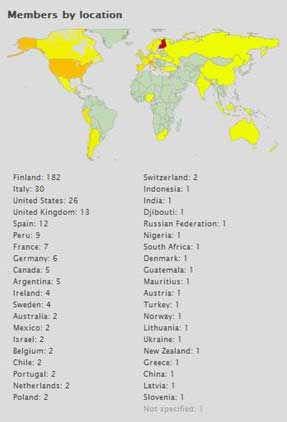
- Opera by You Community Members by Country.
Who are the people collaborating on the project? Do you know the make-up as far as country, age, and profession? Do most have an artistic background and collaborate on areas of the project they specialize in? When it comes to age, they are average 35 years old, mostly motivated by composing and visualizing. We don't collect any information about their profession or education, so we do not know if they already are professionals in the field of opera or classical music.
How do you plan to distribute the opera once it is produced at the festival in 2012? Will the footage be available online, recorded or streaming? The opera will be performed 3 times during summer 2012 in the Savonlinna Opera Festival. If some opera house is interested in the project, we will naturally export the production. We plan to make footage available and also animated movie which will be distributed online. The project was launched at the Opera America annual meeting in L.A. last June.
How are you addressing intellectual property issues for the contributors to the project? Every member has to sign user agreement and accept Wreckamovies terms of use where the member gives all rights to the project. So there will be no intellectual property issues.
What has been the response from the online community and the opera community at large? The community has been growing steadily, but only certain members are active in all "production lines". It goes so that some are writers, some others composers and some only interested in the visualization part. But mainly people are very excited and willing to work "for free". We also want make it easy to just anyone without any classical music or opera experience to participate to the collaborative work. We have reached a very good visibility to our project in the internet. For instance in the launch phase of the project there were lots of articles in online media for instance in Latin America, India and Europe. The larger opera community has been very interested and curious. We have been asked to present the project in several conferences and seminars. People are also very interested in the process itself--how has it been ”structured” etc. within opera community but also in the larger community of art, theatre and even social media.
Here's a more detailed answer to the question "What is crowdsourcing?"
10 Arts and Culture Mobile Apps from 2010
Merely half a day away from the end of the year, today is a great day to reflect on all the different happenings in 2010. One of the big things I have been looking back on is the growth of useful mobile apps for arts and culture audiences and managers. Here is a look at ten of these apps from the past year selected by the Technology in the Arts team and you, our lovely readers:
The Florida Grand Opera | FREE
Available for: iPhone, Android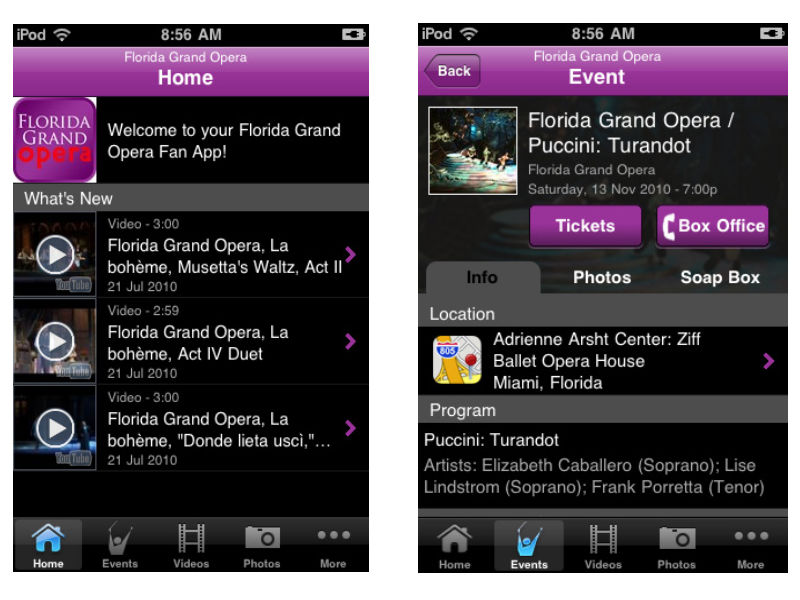 The Breakdown: A great app for the Opera lover in us all, the Florida Grand Opera app offers news about the company, events updates, listings of upcoming performances, and streaming audio of the 2010-2011 season. One aspect of the app I really enjoyed was the videos section, containing a multitude of interviews and performances from the FGO. The only real complaint I have about the app is the necessity to sign up for updates from FGO before being allowed access into the app.
The Breakdown: A great app for the Opera lover in us all, the Florida Grand Opera app offers news about the company, events updates, listings of upcoming performances, and streaming audio of the 2010-2011 season. One aspect of the app I really enjoyed was the videos section, containing a multitude of interviews and performances from the FGO. The only real complaint I have about the app is the necessity to sign up for updates from FGO before being allowed access into the app.
Google Goggles | FREE
Available for: iPhone, Android
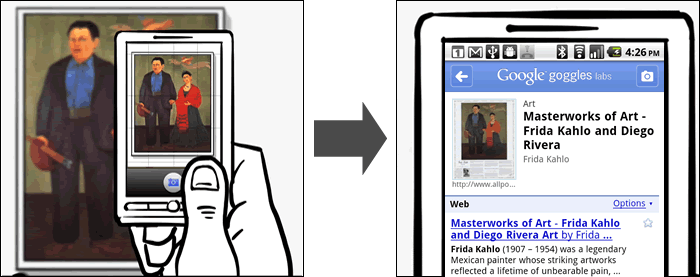
The Breakdown: Google Goggles is a visual search engine built into a mobile app. It utilizes your smartphone's camera to capture and scan an image, object, or landmark and perform a search online to provide information on it. This is a very fun app to play around with and can be very helpful when trying to identify an artwork without a clear label or an unknown landmark. The app is still in beta though and cannot identify anything that is not already currently online in some form.
The L.A. Phil | FREE
Available for: iPhone, Android, & Blackberry
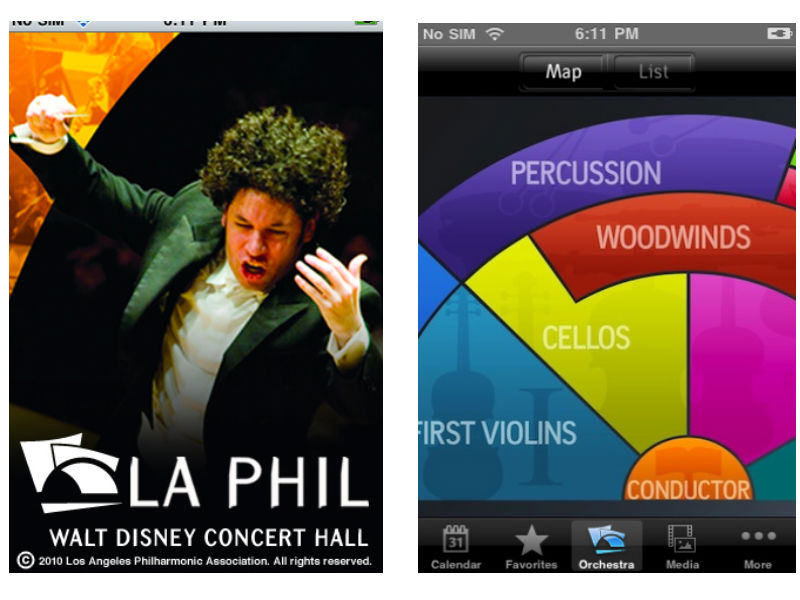 The Breakdown: The LA Philharmonic app has a lot of same offerings as the Florida Grand Opera app in terms of news, media, and listings of events. What sets this app apart is the interactive Orchestra map, laying out the different groups of muscians in the LA Phil. When a user taps on a section of the orchestra, such as First Violins, they are directed to profiles of each musician with in-depth biographies. This app is packed full of great content and an excellent way to learn more about classical music and the people that perform it.
The Breakdown: The LA Philharmonic app has a lot of same offerings as the Florida Grand Opera app in terms of news, media, and listings of events. What sets this app apart is the interactive Orchestra map, laying out the different groups of muscians in the LA Phil. When a user taps on a section of the orchestra, such as First Violins, they are directed to profiles of each musician with in-depth biographies. This app is packed full of great content and an excellent way to learn more about classical music and the people that perform it.
AMNH Explorer | FREE
Available for: iPhone
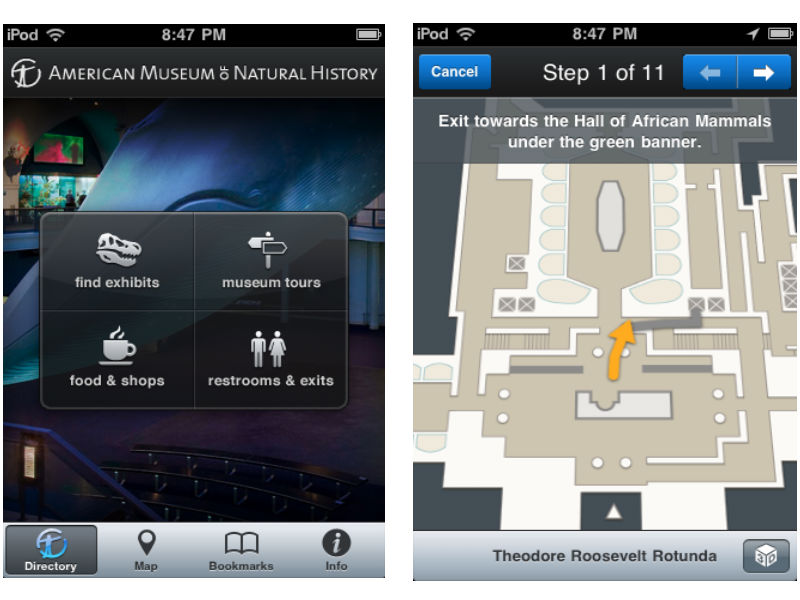 The Breakdown: The Explorer app from the American Museum of Natural History is a great guide for navigating a very large museum. The app acts as a personal in-museum GPS, finding your location and providing information on the exhibits within that area. The app can not only find your location, but provide turn-by-turn directions from one exhibit to the next. This may go against some museum purists love of getting lost within a museum, but on a busy day in a museum packed with visitors this app could be an incredible advantage.
The Breakdown: The Explorer app from the American Museum of Natural History is a great guide for navigating a very large museum. The app acts as a personal in-museum GPS, finding your location and providing information on the exhibits within that area. The app can not only find your location, but provide turn-by-turn directions from one exhibit to the next. This may go against some museum purists love of getting lost within a museum, but on a busy day in a museum packed with visitors this app could be an incredible advantage.
Is This Art? | FREE
Available for: iPhone
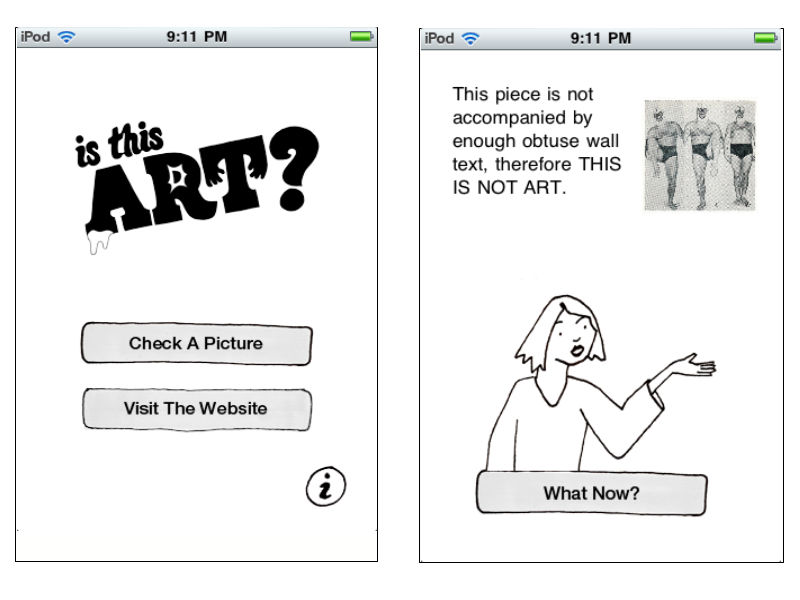 The Breakdown: A fun app from the folks at Deeplocal and the Mattress Factory, Is This Art? is one way to win those age old arguments about what is and isn’t art. Users snap a picture of the art in question and open it within the app to test its validity in the art world. The explanations the app gives are often hilarious such as, "This makes me feel intellectually inferior, therefore THIS IS ART" and, "This piece is not accompanied by enough obtuse wall text, therefore THIS IS NOT ART". All of the images users put to the test can be uploaded to the project's ongoing blog.
The Breakdown: A fun app from the folks at Deeplocal and the Mattress Factory, Is This Art? is one way to win those age old arguments about what is and isn’t art. Users snap a picture of the art in question and open it within the app to test its validity in the art world. The explanations the app gives are often hilarious such as, "This makes me feel intellectually inferior, therefore THIS IS ART" and, "This piece is not accompanied by enough obtuse wall text, therefore THIS IS NOT ART". All of the images users put to the test can be uploaded to the project's ongoing blog.
Brooklyn Museum Mobile | FREE
Available for: iPhone, Android, & Blackberry
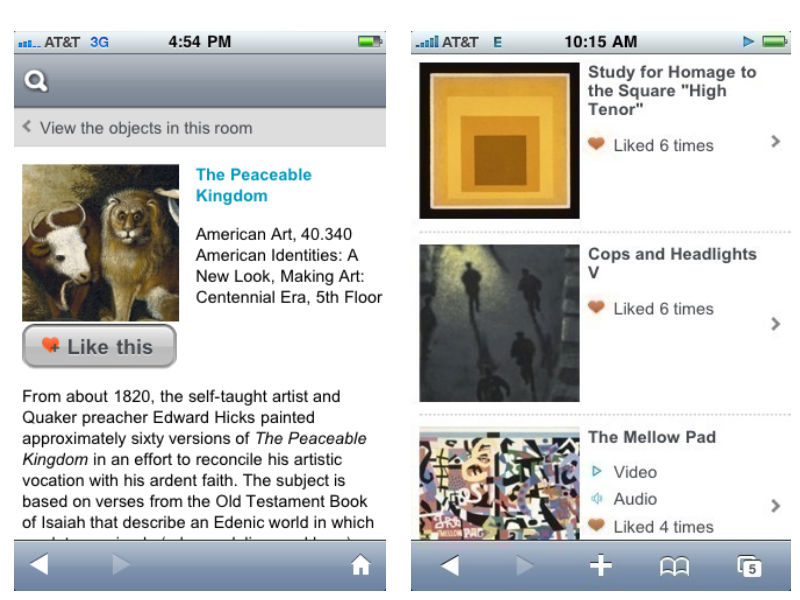
The Breakdown: Another great app for a large museum, Brooklyn Museum Mobile has less of a focus on navigation and more on community and interaction. The app brings in aspects from social media by inviting users to add descriptive tags and/or "like" artworks from the collection. This acts as a recommendation system for other visitors and encourages a more participatory experience. The aspect I like about Brooklyn Museum's offering is that the app runs off of a mobile website, meaning that it is not device exclusive and anyone with a web-enabled device can join in the fun.
The Lighting Handbook | $4.99
Available for: iPhone
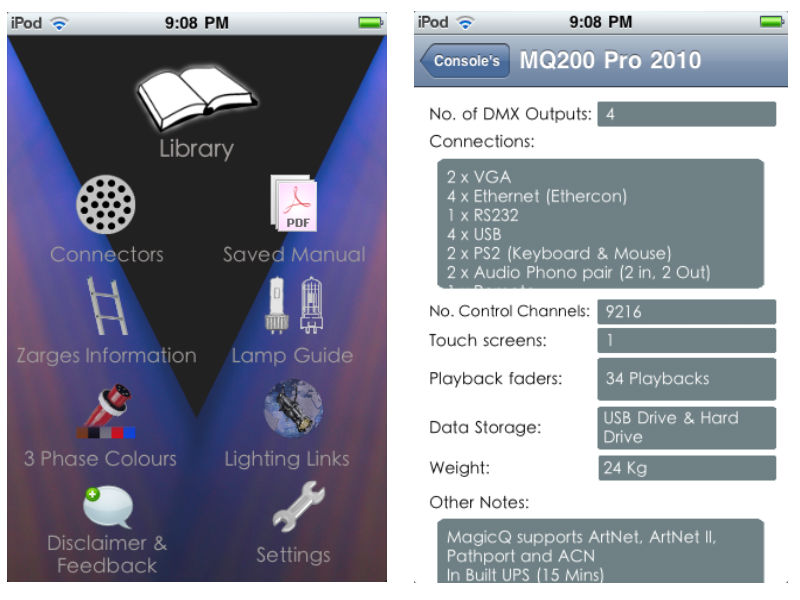 The Breakdown: This is a great app for all of you theater techies. The Lighting Handbook is exactly what it sounds like, an in-depth guide to all things lighting, conveniently in your pocket.
The Breakdown: This is a great app for all of you theater techies. The Lighting Handbook is exactly what it sounds like, an in-depth guide to all things lighting, conveniently in your pocket.
Chicago Gangland Tour | $2.99
Available for: iPhone
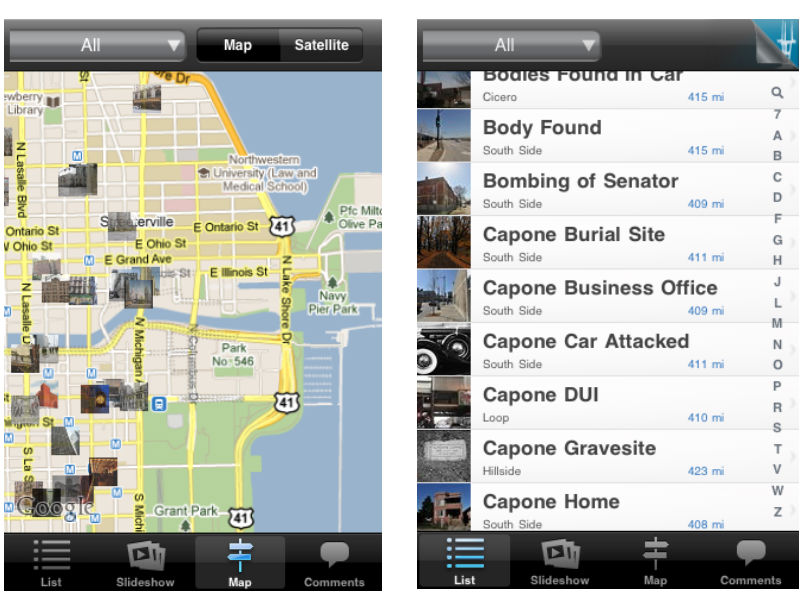
The Breakdown: Ever wanted to walk in the footsteps of famous gangster Al Capone? That's exactly what the Chicago Gangland Tour app helps you do, integrated with google maps to give users a handheld guide for a historical walkthrough of Chicago's mafia history. This app provides info on all the different sites historical relevance and invites users to add their own comments. My favorite aspect of the app is the drop-down menu where results can be sorted by subjects like murders, shootouts, and gangster hideouts.
At The Booth | $0.99
Available for: iPhone, Android
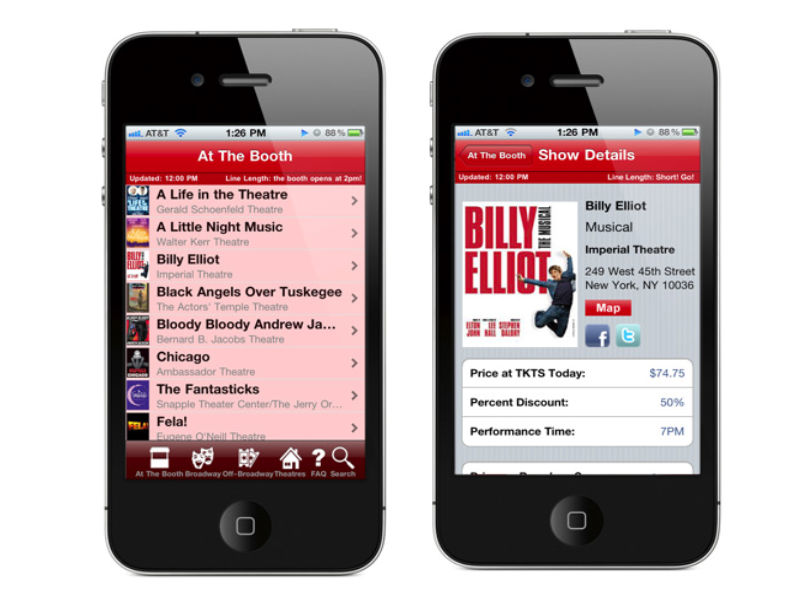 The Breakdown: At The Booth is a full-service app for attendees of Broadway and Off-Broadway shows in New York City. The main page updates with every launch of the app and includes the latest shows and theater locations. For each show the app provides info on the showtimes, ticket prices, discounts, synopses, links to reviews and videos, and nearby restaurants. Listings will appear with a pink undertone to let users know if there are long lines at the theater. The only real complaint I have about the app is that the listings are only viewable in list form, whereas a map option would really assist in seeing all that is available in the immediate area.
The Breakdown: At The Booth is a full-service app for attendees of Broadway and Off-Broadway shows in New York City. The main page updates with every launch of the app and includes the latest shows and theater locations. For each show the app provides info on the showtimes, ticket prices, discounts, synopses, links to reviews and videos, and nearby restaurants. Listings will appear with a pink undertone to let users know if there are long lines at the theater. The only real complaint I have about the app is that the listings are only viewable in list form, whereas a map option would really assist in seeing all that is available in the immediate area.
The Sundance Festival 2010 | $4.99
Available for: iPhone
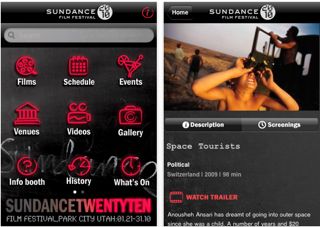
The Breakdown: The Sundance Festival app acts as an online brochure for the annual film festival. In addition to offering videos and reviews on films being shown, the app gives festival attendees real-time updates as to what is happening with the film fest's various events and screenings. The one feature that this app lacks is a way to create custom schedules of screening times and events. This would be invaluable at a festival where multiple things are being offered at once and making the most of the your time requires a lot of planning.
Where we are different, we are the same
This post also appears as part of the Arts Marketing Blog Salon hosted by Americans for the Arts.

- Silos belong on farms, not in arts organizations.
As a writer for the Technology in the Arts blog, I am constantly thinking about which topics will appeal to which artistic disciplines, which specialty, which skill level… and on and on. But the more I have to think about the segmentation of the arts management audience, the more I realize how broad many of the issues we discuss are.
A few months ago, I interviewed Alan Cooke of the e-fundraising company Convio, and we talked at length about the problem of organizational silos. In arts organizations, as in any company, conflicts often arise between different departments and may develop into an “us against them” mentality. As arts organizations become more prevalent in the social media space, it becomes easier to see which organizations have truly good internal communication between marketing, communications, box office and development departments.
We also tend to think that orchestra problems are unique to orchestras, theatre problems unique to theatres, and so on. For example, a few months ago I was at an opera conference listening to a presenter from another artistic discipline, when a colleague leaned over and whispered, “Ok, but what does this have to do with opera?” Unsure how to respond, I sort of nodded in agreement, but later, I couldn’t stop thinking about it. True, it didn’t have much to do with opera, but, I would argue, the point of the conference was to learn new things, not to be told about things we already know.
Working in the non-profit world, we usually don’t pay attention to discussions and proposed solutions going on in the corporate world. We don’t think that their solutions will work for us. I’m in a class right now entitled Social Media Analytics, where the students are split up into teams and assigned a major corporation as a client. At first, I expected that the corporations would have a pretty good handle on their social media presence, in terms of who they were reaching, who they were converting and how they were making money from their social media sites. What I found, however, was that the for-profit companies involved in the project are asking a lot of the same questions that I see posted by non-profit arts companies all the time. How do we track audience engagement? How do we convert brand awareness to sales?
Technology, especially social media, is an industry in high flux. It’s easy to think that there’s someone out there with all of the answers, but the truth is we’ve only begun to understand, let alone master the seismic shift in online behavior and the potential of these new tools. We still struggle to find tools that will accurately “read” sentiment from user comments and accurately extract what people are really saying about our brand. We question whether our tracking of sales due to social media is accurate. We wonder how much effort, which platforms, and which campaigns are really worth our time.
One of the things I am looking forward to most at the NAMP Conference is getting this broad perspective across artistic disciplines. Learning from each other is one of the most important things we can do, and I’m looking forward to seeing how arts marketing, as a specialty, has developed in the past year.
YAP Tracker: Organizing the Uncertain World of Auditions
For most people in the Northern Hemisphere, summer ended last week. But for those who run artist training programs in the summer months, next summer has already begun. In case you are not in the artistic department of your org, newsflash: It’s audition season, folks!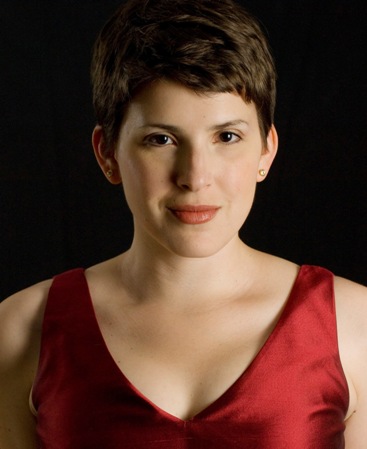
Today I have an interview with Julie Baron, General Manager and one of the founders of YAP Tracker. For those readers not familiar with the field of opera, a "YAP" (Young Artist Program) is a training program for young singers, usually with a large opera company which hires the singers for the season and provides them with small roles in the opera, coachings with staff pianists, and the opportunity to perform in educational outreach programs. The singers have usually graduated fairly recently from a Masters or Artist Diploma program and are trying to launch their singing career.
Having left a career in technology solutions consulting and training to pursue her passion for the arts, Julie Baron earned her Master of Music degree in Vocal Performance from the Manhattan School of Music in 2004. She enjoyed a career as a mezzo-soprano singing with many companies throughout the United States and abroad, but her unusual affinity for both technology and the arts ultimately guided her to create the popular website YAP Tracker.
YAP Tracker was created in 2005 and has quickly garnered tremendous acclaim for its comprehensive, worldwide list of opportunities and online application service. We've talked about online application and review tools in the past on the Technology in the Arts blog, but YAP Tracker is truly unique in its industry specificity and the fact that it provides organizational features for singers, teachers and company administrators alike.
"We’re so grateful for the support that we’ve gotten from both companies and singers alike and we hope to be around for many years to come to help people find auditions," Julie said. Julie is also a frequent guest speaker at schools, programs and conferences on the use of technology in the arts, including the 2010 Opera America Conference.
How did you come up with the idea for YAP Tracker?
The site began in 2005; I was singing with the Opera Colorado Outreach ensemble and I competed in a competition there locally, the Denver Lyric Opera Guild competition, and placed well. I was really excited about it and I wanted to find other opportunities to compete. I started looking and I couldn't believe how much was out there—so much that it was difficult to keep track. So, the site was designed with this in mind. It was originally designed for me actually to use and my friends were incredulous that such a thing existed and so I became willing to sell it to them. So, now we have about 8,000 members worldwide and we list 2,500 auditions a year. They come from everywhere—I think we even have some singers in Guam and Congo—places that I wouldn’t have even realized that there was a need for the service, but apparently there is.
What experiences that you’ve had personally as a singer informed how you created the interface and how you do business as a company? That’s an interesting question. My background is sort of unusual because I have both a technology and a musical background. Before I went back to school for singing, I actually worked as a technology solutions consultant for PriceWaterhouseCoopers. It was important to me that the site be very user-friendly because generally the use of technology is frightening for everyone, so it was important for the site to be able to cater to every level of singer no matter what their technology background. I think that having a higher level of technology background was a good place to start from—to go from the ground up.
So, say I’m a singer and I’m looking for an audition. I find one that’s perfect for me, on YAP Tracker. Where do I go from there? Generally you start a few steps before that. When you subscribe to YAP Tracker, you receive alerts to let you know about new and interesting opportunities that are coming up. They’re interesting because the site is designed in such a way that you filter before you ever receive opportunities that you know will not be of interest to you. So, anything with a particular age limit, if you know that you’re not interested in doing competitions or auditioning in Europe, those opportunities are filtered out for you automatically. If you see something in the alerts that you do like, you go to the site, you click an icon to say "put this in my queue and remind me of all the important details about this opportunity." As the deadline approaches for that opportunity, you’ll receive additional alerts through the site and through our email alert system to let you know that things are coming up. Once you’ve actually sent your application, you click another icon to say “I’ve sent it; stop bothering me” and it goes into another queue. At that point, once you receive notification that you have an opportunity for an audition or that you don’t have an opportunity for an audition, you enter that information and that enters your audition queue. It sort of helps you through every step of the process to make sure that it’s on your mind, that you’re remembering the information that you sent in, and that you’re not surprised when the next date approaches.
You said that you had over 2500 listings. Do you cull the listings yourself or do organizations and competitions enter them or send them to you? Both—there are a lot of opportunities that I find and I contact the organization to let them know that we’ll post it or there are plenty of opportunities where the organization will write to us to say, "could you post this for me?" and they’ll send us the information. Then there are also organizations that have accounts with us and list the information themselves.
Auditioning can be an intimidating and exhausting process. How does YAP Tracker streamline that and take the mystery out of the audition process? Well, we can’t. It’s the one thing that we can’t do. We cannot make auditions themselves any easier for singers. It’s a difficult process, the preparation for auditioning. I will never regret that I’m not doing that anymore because that is the hardest thing that we, as singers, do. And singers do it forever, unless they’ve attained a certain level--which God love them, those who do. The one thing that we can do is make the rest of the process easier. One of the things that we say is “you sing well and we’ll take care of the rest.” We try to take the incredible ordeal out of keeping track of applications, which for many singers is a tremendous organizational feat. I remember when I was doing it myself before the existence of YAP Tracker, I would have this elaborate Excel spreadsheet to make sure that everything was lined up in date order so that I would send things in on time. Now we actually also offer an online application service, which some companies use, which makes the process even easier, so singers can apply to things with the click of a button. I think that if singer have confidence going into an audition knowing that they know what songs they’re going to sing, since they’ve kept that information in the site materials. They can refer to what they sang for that organization last year, because we never remove anything from the site. That’s the best we can do. Singers have to do the rest.
You said that you have artistic staff at opera companies using the program. Tell me a little more about that. Some organizations like to send us their audition information, but others prefer to list the information themselves. Companies can sign up for a free company account, which gives them access to list their opportunities. Other companies use the online application service, which is a fee-based option. Most companies still use a paper-based system; this is frustrating for singers in that it takes a long time to compile and combine and send it off. It can be very expensive to reproduce materials or FedEx, if you’re the type of person who does things at the last minute. They’re also a pain for organizations, when you’re dealing with 800 packets, as companies do, if there’s one headshot missing or if there’s a singer who’s missing a material, etc. A couple of years ago, we developed an online solution to help streamline the process, both for companies and singers alike. And the people who use it have been extremely positive about it, because it helps reduce their workload significantly.
What's one of the most popular features you would like to highlight? There’s so many good features—one of the most popular features that singers like is the section of the site geared towards accompanists, that allows for accompanists to indicate their availability to play for auditions. So, if you’re going to Cincinnati and you don’t happen to know anyone and you’re required to bring your own accompanist, there may actually be a pianist who’s indicated that they’re available to play, so that’s something that a lot of singers and accompanists are happy about. We also offer audition swapping functionality, which is great if you happen to not be available during the time that you’ve been given or if you’re a not a morning person and you’ve been given a 9:05 audition timeslot, there’s a place that you can go to change that. We also have a lot of new features that we’re looking forward to releasing soon, so I’m not going to talk about them until they’re ready, but we’re hopeful to have a new release on the site for 2011.
Social Media Spotlight: Vancouver Opera
Welcome to the first installment of the Social Media Spotlight, our monthly feature focusing on arts organizations’ social media strategies.

Vancouver Opera’s social media presence, headed by photography/fashion buff and technology maven Ling Chan, goes where few opera companies have gone before. In order to achieve their goal of increasing brand awareness and facilitating two way communications with their followers, the $9 million opera company has launched initiatives like manga (a traditionally Japanese style of comic) and an annual animation contest, for instance. Currently on the company’s blog is a serial feature written in the voice of the main character of their world premiere opera, Lillian Alling.
Vancouver Opera takes ideas that many non-profit arts companies might deem risky or unsustainable and, through a combination of sheer creativity, thorough execution and diligent tracking, have made the Vancouver Opera social media sites vibrant, interesting, and unique.
Social Media Manager Ling presented her work this summer at the Opera America Conference. I caught up with her to chat:
Everything in the Vancouver Opera social media presence looks so vibrant. When you first set out, what were your goals for your organization and your audience?
Thanks! Vancouver Opera is a vibrant and innovative company that loves to engage with our community. When we first started out with social media, our goal was to put a face on the organization as well as increase awareness of the art-form of opera through educating and entertaining our tech savvy, minimally to moderately engaged supporters. Vancouver Opera was one of the first arts organizations to really use social media tools. From the start, we were committed to reaching the next generation of opera lovers using the media of the times and integrating it into our marketing/PR mix.
Your summer blog features keep your readers captivated during Vancouver Opera's off-season. Tell me about Opera Mania 101 and the other summer blog features.
During the summer months, we needed to come up with ways to keep our followers engaged, so we came up with some regular features for the blog. • Operamania 101 is a feature I came up with and thought would be helpful for the opera-curious. It’s opera education from a pop culture perspective. Everyone’s heard snippets of opera in movies, TV shows, cartoons and commercials and yet people might think they don’t know opera. They are more familiar with opera than they think. Some other blog features have included: • Bizarre Opera Videos where we post odd, unusual, or notable performances of opera found on YouTube. • Tuesday Trivia where we come up with opera themed quizzes. • Top Ten Lists where we invite readers to vote for their #1 choice. For example: Top 10 Villains, Top 10 Opera Tearjerkers, Top 10 Fantasy Operas • Other features: 20 Questions with an Artist, Everyone’s a Critic, Lunchtime Poll, Opera Props
Lego Carmen, one of the "Bizarre Opera Videos" posted by Vancouver Opera to keep interest in opera during the summer months
You have a background in photography. Was this the impetus for Flickr Fashion at the Opera? What are the goals of the program and what inspired you to create it?
I love taking pictures and I have always had a passion for fashion. I went to fashion design school years ago and worked as an assistant stylist on a couple of magazine and music video shoots. While working down at the theatre during Eugene Onegin in November 2008, I couldn’t help but notice how many young people went all out, dressing themselves “to the nines” for our operas. It wasn’t all just formal wear either. Our audiences mixed dressing up with elements of street, punk and preppy fashion, bringing a whole new flava to the world of opera. The people who dressed up for our operas inspired me to come up with Fashion at the Opera, which you can find on our Flickr.
Describe Blogger Night at the Opera. How did it engage new audiences? Did it show an increase in sales?
Our very first Blogger Night at the Opera was in January 2009 for our Carmen opera. A prominent local blogger named Rebecca Bollwitt, aka Miss 604, came to our Eugene Onegin that previous fall and she ended up blogging about the experience on her own personal blog. We got to talking and she suggested we coordinate a blogger night, which we did and it has since became so wildly successful that other opera companies started calling us to find out how to set it up for themselves.
We invited bloggers who were opera newbies to join us, blogging pre-show and during intermission their thoughts on the opera and the whole experience of being at the opera. We gave them backstage tours and also invited them to mingle with cast, staff and guests at the post-show party on opening night.
We live streamed their web links on our VO blog, so that our readers can follow along in real time. This was great exposure for us and a way of getting the next generation interested in opera. Most of their readers have never been to the opera. But after reading about Blogger Night at the Opera, they became excited about our operas and what we’re doing with social media and bought tickets to the next performances. I had a few of them seek me out on the theatre floor to tell me they were here because of Blogger Night at the Opera.
What's Opera Ninja and how did you come up with the idea? How do other people in the organization feel about giving control of their communications over to (basically) a volunteer?
Opera Ninja evolved from Blogger Night at the Opera. We had blogger night on Opening Night. What should we do for dress rehearsal? We came up with Opera Ninja March 2009 for our Rigoletto dress rehearsal.
It was inspired by Welsh National Opera when they tweeted 12 hours in the life of the Welsh National Opera's The Marriage of Figaro, including a live relaying of the performance (also translated into Welsh).
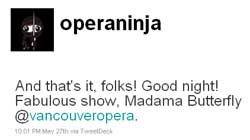 On our dress rehearsal nights, the Opera Ninja would live tweet. Followers were engaged with seeing an event unfold and have an insider view of what was going on behind-the-scenes. The tone of Opera Ninja is cheeky, fun, irreverent. We didn’t necessarily want it to be a play-by-play of what was happening on the stage. Instead it could be the Opera Ninja’s reactions to what was going on. Our followers have found this entertaining and fun. They would add comments and also re-tweet our tweets to their own followers.
On our dress rehearsal nights, the Opera Ninja would live tweet. Followers were engaged with seeing an event unfold and have an insider view of what was going on behind-the-scenes. The tone of Opera Ninja is cheeky, fun, irreverent. We didn’t necessarily want it to be a play-by-play of what was happening on the stage. Instead it could be the Opera Ninja’s reactions to what was going on. Our followers have found this entertaining and fun. They would add comments and also re-tweet our tweets to their own followers.
I was the original Opera Ninja but have since invited our bloggers to take on the character in their own voices. I give a lot of freedom to our Opera Ninjas in what they tweet because I trust them. They are high-profile and active Twitter users. They know the etiquette, the advantages and the drawbacks of Twitter. They understand that they can have fun as the Opera Ninja but as they’re also representing VO for the night, they have to be professional too.
Vancouver Opera has started publishing manga, a comic book based on the opera. Manga is sort of an unusual foray for an opera company to take. What inspired you to take the stories of operas to this new medium?
It may sound like a strange combination but the partnering of opera and manga has worked extremely well for us. We were approached by Vancouver artist & editor Roy Husada of Rival Schools four seasons ago with the idea of “manga-nizing” our operas. It started out in black & white and written in Japanese, but has evolved into colorful mangas in English. The mangas are eye-catching and it helps give readers an idea of what the opera is about, thus sparking their interest in coming to the opera. Our mangas have proven to be very popular with our followers.
By my count you have at least four Twitter accounts for Vancouver Opera. Why? What are the advantages to have many accounts? And how do you track and get a good picture of your audience?
We have 4 Twitter accounts: 1. Vancouver Opera which is our main Twitter account where I tweet daily. It's the one with the most followers and the most activity, so it’s this account where I keep track and measure all our questions, responses and re-tweets.
2. Operabot which was started for our Operabot contest, an animation contest for our Golden Anniversary season. Professional and student animators were challenged to create animated shorts of one of the four productions last year. The tweets posted to Operabot related to updates on the contest, the submissions received and any fun or wacky robots related links.
3. Opera Ninja – We wanted a dedicated Twitter account just for our exclusive “behind the scenes” tweeting during dress rehearsals.
4. Where’s Lillian – For our upcoming world premiere, we wanted to introduce our Twitter followers to Lillian Alling as she makes her epic North American journey from Ellis Island to the wilds of British Columbia. She travels on foot in search of a man named Josef. We have someone taking on the persona of Lillian Alling and tweeting in their own voice the adventures and hardships that the real Lillian Alling might have encountered. From these tweets, we hope that followers will become intrigued with Lillian Alling and want to come to the opera.
Each Twitter account serves a different purpose and we wanted to have a dedicated account for the audience who wanted just Operabot updates or just Opera Ninja updates. Also it frees up our main VO Twitter stream by not bombarding our followers with too many tweets or random-sounding trains of thoughts.
What have been the results of all of these programs for Vancouver Opera? Many times it is difficult to track the effects of social media programs. How have you been tracking your initiatives at Vancouver Opera?
Our social media initiatives have garnered a lot of positive attention from newcomers to opera, opera lovers, our peers in the industry and the media.
I track and report data to measure the impact of our social media efforts in various ways: • Blogger – Google analytics, Like This / Tweet This buttons • Facebook – analytics • I use the Bit.ly shortener for our tweets to see how many people click on our links • Through promo codes in our Tessitura software, I can find out how many tickets were purchased whenever a sales offer was put forth on our social media channels.
Any initiatives for the 2010-2011 season that you'd like to preview for us?
I have some exciting things planned but it’s a surprise. Everyone will just have to stay tuned to Vancouver Opera.







